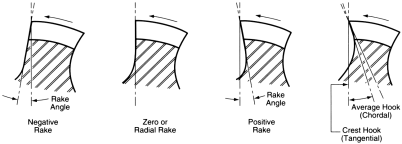

ANGLE OF THREAD - The angle included between the flanks of the thread, measured in an axial plane.
BACK TAPER - A gradual decrease in the diameter of the thread form on a tap (or a gradual increase on a die) from the chamfered end of the land toward the back which creates a slight radial relief in the threads.
BASIC - The theoretical or nominal standard size from which all variations are made.
CHAMFER - The tapering of the threads at the front end of each land of a tap by cutting away and relieving the crest of the first few teeth to distribute the'cutting action over several teeth. When the tapering amounts to 8 to 10 threads, the tap is called a "Taper" Tap; 3 to 5 threads, a "Plug" Tap; and 1 to 1-1/2 threads, a "Bottoming" Tap.
CHAMFER RELIEF - The gradual decrease in land height from cutting edge to heel on the chamfered portion, to provide clearance for the cutting action as the tap advances.
CREST - The top surface joining the two flanks of a thread. The crest of an external thread is at its major diameter, while the crest of an internal thread is at its minor diameter.
CUTTING FACE - The leading side of the land in the direction of rotation for cutting on which the chip impinges.
FLUTES - The longitudinal channels formed in a tap to create cutting edges on the thread profile and to provide chip spaces and cutting fluid passages.
HEIGHT OF THREAD - The distance between the crest and the base of a thread measured normal to the axis.
HELICAL FLUTES - A flute with uniform axial lead and constant helix in a helical path around the axis of a cylindrical tap.
INTERRUPTED THREAD - A tap having an odd number of lands, with every other tooth along the thread helix removed.
LEAD - The distance a screw thread advances axially in one complete turn. On a single lead screw or tap, the lead and pitch are identical. On a double lead screw or tap, the lead is twice the pitch, etc.
THREADS PER INCH - The number of threads in one inch of length.
PITCH - The distance from any point on a screw or tap thread to a corresponding point on the next thread, measured parallel to the axis. The pitch equals one divided by the number of threads per inch.
PITCH DIAMETER - On a straight thread, the pitch diameter is the diameter of the imaginary co-axial cylinder, the surface of which would pass through the thread profiles at such points as to make the width of the groove equal to one-half of the basic pitch. On a perfect thread this occurs at the point where the widths of the thread and groove are equal. On a taper thread, the pitch diameter at a given position on the thread axis is the diameter of the pitch cone at that position.
RAKE - The angular relationship of the straight cutting face of a tooth with respect to a radial line through the crest of the tooth at the cutting edge. Positive rake means that the crest of the cutting face is angularly ahead of the balance of the cutting face of the tooth. Negative rake means that the crest of the cutting face is angularly behind the balance of the cutting face of the tooth. Zero rake means that the cutting face is directly on a radial line.
ROOT - The bottom surface joining the flanks of two adjacent threads. The root of an external thread is at its minor diameter, while the root of an internal thread is at its major diameter.
SPIRAL POINT (CHIP DRIVER) - A supplementary angular fluting cut in the cutting face of the land at the chamfer end. It is slightly longer than the chamfer on the tap and of the opposite hand to that of rotation.

